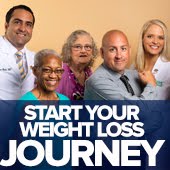Exercise & Nutrition: Tips from Katie Perry, RDN
11:06 AM
 A healthy lifestyle begins in the grocery store, and when you're ramping up your exercise in addition to dieting, it's important to take in proper nutrients while expelling those extra calories. Read on for low-fat nutrition tips that will fuel you to the finish line.
A healthy lifestyle begins in the grocery store, and when you're ramping up your exercise in addition to dieting, it's important to take in proper nutrients while expelling those extra calories. Read on for low-fat nutrition tips that will fuel you to the finish line.
Plan ahead
GBMC Registered Dietitian Katie Perry recommends having a plan before food shopping. Since working out takes time away from your planning, cooking and shopping, having a list of healthy meals and snacks to keep you on track is crucial. Committing to buying only the items on your list can help you bypass impulse purchases and ensure healthy ingredients will be on hand. Whatever you do, don't grocery shop when you're hungry. Shopping on an empty stomach can lead you to indulge your cravings and make poor choices. Have a protein and fiber-filled snack before leaving home to help you avoid tempting treats. Try veggie sticks and hummus, a piece of fruit or a serving of Greek yogurt to hold you over.
Navigating the aisles
Start by shopping the outer aisles of the store, which are a safe bet for locating the more natural, whole foods that your store carries. This is where you'll find fresh produce, dairy and deli. Steer clear of the bakery, though! Your goal should be to buy and eat food in its most natural state so that it provides you with maximum nutrition. Most foods found in the inner aisles – cereal, chips, crackers, cookies, granola bars, candy and soda – contain highly-processed ingredients and added sugars.
However, there are a few worthwhile aisles to venture down for shelf-stable sources of nutrients. Explore the frozen aisle for fruits and veggies that are flash-frozen, which preserves freshness. Stock up on carrots, broccoli, or whatever veggie blends appeal to you. Combine them with a protein for a quick meal. Choose no-sugar-added frozen blueberries and strawberries for adding natural sweetness, fiber and antioxidants to a smoothie.
The canned food aisle can be tricky: go for canned tuna in water (not oil) and canned beans with no salt added. These foods are an easy way to add extra protein to a salad or wrap. Try to stay away from pre-packaged soups, sauces and condiments, which can be full of hidden sodium and sugar. A can of vegetable soup could have 1,300 milligrams of sodium; you want less than 140 milligrams per serving. A cup of tomato sauce can add up to more than 20 grams of sugar; you want less than six grams per serving.
Understand labels
Investigate food labels carefully to be sure you have an accurate grasp of serving size, which is located at the top of the label. Sometimes a food will seem a lot less healthy when you realize it is meant to be consumed in two or three servings instead of one. Look for foods that have a protein value higher than the amount of fat per serving. Examples include skinless turkey breast, black beans and part-skim mozzarella.
Quality, not quantity
Rather than focusing on the total amount of calories, pay attention to the quality of those calories. For example, Oikos Triple Zero Vanilla Greek Yogurt has 120 calories, while Dannon Light & Fit Greek NonFat Vanilla Yogurt has only 80 for the same 5.3-ounce serving. However, the Oikos has fiber (six grams as opposed to zero in the Dannon) and more protein (15 grams as compared to 12). The additional fiber and protein will keep you fuller longer, making those extra calories pay off.
Supplements, shakes and bars
When life leaves you without time to prepare a midday snack or meal, Perry says its acceptable to reach for an energy bar or shake, as long as you're making good choices. Choose a protein-packed bar (she recommends Quest) or powder (she recommends Isopure, Nectar, and Chike) that contains less than 200 calories per serving and lists whey protein isolate as the first ingredient. Mix your shake with water, skim milk or unsweetened soy or almond milk.
After a high intensity workout of 30 minutes to an hour during which you are sweating and/or breathing heavily, it can be helpful to replenish your electrolytes. Avoid sugary sports drinks and fruit juices. Perry recommends Powerade Zero or Gatorade Zero. You can also try an electrolyte tablet called nuun, which is easy to keep in a purse or desk drawer and add to any bottle of water.
In addition to protein, make sure that your active lifestyle includes enough of the electrolytes potassium, calcium and magnesium. Low-fat food sources of these nutrients include leafy greens, fish, beans, yogurt and dried fruit.
Hydrate!
As June's 5K gets closer and the weather warms up, you'll likely find yourself perspiring more and losing liquid at a higher rate. Replenish with water before, during and after your training to stay hydrated. Remember that exercising makes you hungrier, so reach for water before filling up on snacks for more satiety and then go for nutrient-dense, high-protein, high-fiber foods.





0 comments